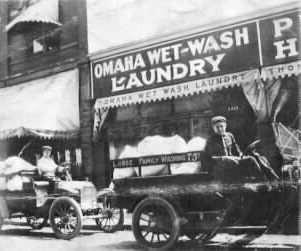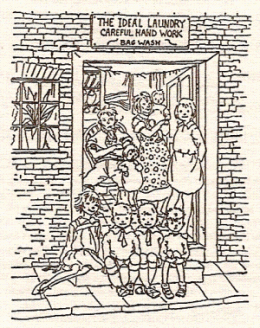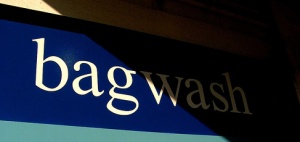-
History of:
- Resources about:
- More:
- Baby walkers
- Bakehouses
- Bed warmers
- Beer, ale mullers
- Besoms, broom-making
- Box, cabinet, and press beds
- Butter crocks, coolers
- Candle snuffers, tallow
- Clothes horses, airers
- Cooking on a peat fire
- Drying grounds
- Enamel cookware
- Fireplaces
- Irons for frills & ruffles
- Knitting sheaths, belts
- Laundry starch
- Log cabin beds
- Lye and chamber-lye
- Mangles
- Marseilles quilts
- Medieval beds
- Rag rugs
- Rushlights, dips & nips
- Straw mattresses
- Sugar cutters - nips & tongs
- Tablecloths
- Tinderboxes
- Washing bats and beetles
- Washing dollies
- List of all articles
Subscribe to RSS feed or get email updates.
As late as 1949, the so-called ''home routes'' ... were serviced by horse and wagon. ... the horses knew the customers' addresses and invariably stopped in front of the next building for a pickup of dirty laundry. Incidentally, in 1948 the price for 25 pounds of wet wash was $1.60, picked up soiled at 6 a.m. and delivered clean and extracted later the same day.
Letter in New York Times, 2000
I had to help unload the wagons, and open the big bags of dirty clothes people send to wet wash laundries. Then I had to sort out and pin the clothes together with numbered pins so that, once washed, they could be reassembled again. I never dreamed human beings sent such dirty clothes to a laundry. But I knew that, as a rule, only very poor people use wet wash laundries.
Langston Hughes describing Washington DC around 1924 in his autobiographical The Big Sea, 1940
"A Bag Wash". Certain laundry firms supply bags of stout material, into which the bag-wash patronizer stuffs as many "boiling" articles as she can. The laundry folk collect the bags, boil the contents of each bag separately, and return the articles rough dried; the finishing processes are done at home....
English-Speaking Union, The English-Speaking World, London 1919
Bag wash & wet wash
Cheap laundry services in the 20th century before the laundromat/launderette
 Before coin-operated self-service
laundries were introduced, how could people on modest incomes get their clothes
clean without boiling up tubs of water, and spending hours rubbing on a
board or working with a "dolly"?
Before coin-operated self-service
laundries were introduced, how could people on modest incomes get their clothes
clean without boiling up tubs of water, and spending hours rubbing on a
board or working with a "dolly"?
There were plenty of labour-saving washing machines in city laundries in the early 1900s. Many of these laundries didn't just cater for people who wanted their things beautifully starched and pressed. They also offered a "wet wash": tackling bags of dirty linen and clothes for a small payment and returning them still damp.
The answer ... is an ordinary delivery wagon and its name is "wet wash". Wet wash, however isn't wet. It is damp. Just ready to hang out or starch.
... get the worst part of the wash done for a little over a dollar.
New York Times, 1921
 In
the UK the system was known as the bag wash, or bagwash, and was sometimes offered
by independent washerwomen working from home, as in the illustration (left) from
a 1937 children's book, The Family from One End Street.
In
the UK the system was known as the bag wash, or bagwash, and was sometimes offered
by independent washerwomen working from home, as in the illustration (left) from
a 1937 children's book, The Family from One End Street.
Since the bagwash could be so useful to the urban poor, especially to over-burdened women in cramped housing, it was of interest to social reformers. It was an alternative to municipal wash-houses where hot water and other facilities were available even more cheaply than the bagwash, but without saving time and effort.
After discussing the objections to existing communal washing arrangements...the Committee...described the "bag wash"...
Each bagful would be washed separately, wrung with a hydro [electric wringer?], and "rough dried", the ironing being left to be done at home...
This plan would rid the housewife of the heaviest and most unpleasant part of her "washday".
1919 recommendations of a women's committee advising the UK government, from a report in The Scotsman
There were concerns about this system, though. A 1917 US study by the Association for Improving the Condition of the Poor found that some wet washes were "unsanitary". Laundry was sometimes washed in nets, bundle by bundle, and this prevented "the proper application of disinfectants, soap, water, and heat". Keeping the laundry damp in bags for a long time added to hygiene problems.
Outside hung a blue board on which was painted in large white letters, "The Ideal Laundry. Careful Hand Work", and underneath, in smaller letters, the mysterious words "Bag-wash".
Eve Garnett, The Family from One-End Street, 1937
The first coin-operated washing machines appeared in the US in the 1930s, and in the UK in 1949. The rise of the self-service laundry put an end to bagwash and wet wash services which returned the laundry without drying it. The name bagwash lives on in some places, like Australia, to describe inexpensive "per load" laundry deals.
 18 June 2008
18 June 2008
You may also like:
History of laundry in the 1800s
Making ironing easier in the early 1900s
Other laundry articles on this site
You may like our new sister site Home Things Past where you'll find articles about antiques, vintage kitchen stuff, crafts, and other things to do with home life in the past. There's space for comments and discussion too. Please do take a look and add your thoughts. (Comments don't appear instantly.)
For sources please refer to the books page, and/or the excerpts quoted on the pages of this website, and note that many links lead to museum sites. Feel free to ask if you're looking for a specific reference - feedback is always welcome anyway. Unfortunately, it's not possible to help you with queries about prices or valuation.



